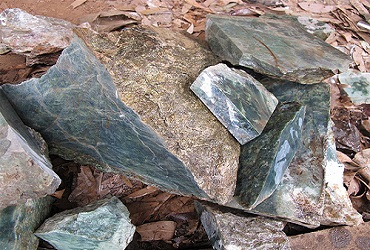What is jade
Background
Jade is an ancient stone dating back in the Chinese civilisation to 5,000 BC. It is loved by the Chinese not only for it's beauty and durability but for it's cultural significance and is as loved and treasured today as it has been throughout the history of China.
In China jade represents Virtue, Purity, Intelligence, Loyalty and Justice. Internally jade may be flawed but these interior flaws are believed to represent sincerity.
Chinese say... , Gold has a value.... Jade is invaluable.
Throughout time jade, because of it toughness and durability has had a wide variety of use from articles of adornment, household utensils to weapons such as axes and daggers.
There are two types of jade, Jadeite and Nephrite. Jadeite is a pyroxene with a chemical formula of Na(Al,Fe+++)Si2O6.
Nephrite is an amphibole, not a distinct species but a variety of a mineral in the Ferro-actinolite/Tremolite series of minerals.
This being said, whilst testing can determine the composition of a mineral, Nephrite can be a difficult mineral (gem) to identify.
Iron rich Nephrite appears black. Our Australian Black Jade is as black as Nephrite can get and is virtually opaque, which not a desirable feature of Jade in China. However, the Black Jade has been tested as being the same as Hetain Jade (Hetain Yu).
Hetain Yu is the 'standard jade' that Chinese lapidaries seek for there processing. The look for translucency, even in black jade and the deeper you can see inside the gem with a strong light the more desirable is the piece,
Nephrite Jade is found in Numerous countries but by far the largest deposit is at Cowell in South Australia.
The Cowell deposit has produced over 1,500 tonnes of rough boulders of Nephrite in a variety of hades of greens and in a variety of patterns. Cowell Jade is has the potential to produce the largest pieces of Jade in the world with boulders up to 8 tonnes being mined in the past. The Cowell Jade Province stretches over several kilometres and has numerous visible outcrop.
Because Nephrite is a 'variety' as opposed to a species, it can be difficult to resolve issues when dealing with the gem in China. The X-Ray pattern can be identical to patterns of Hetain Yu but some testing laboratories will not give a certificate determining the material as 'Nephrite'. A determining factor is a visual observation relating to the microcrystalline nature of the material in question. This cannot be tested.
Jadeite, being a distinct species can be tested and proven to be Jadeite and there is no such difficulty as is encountered with naming a gem 'Nephrite'.
Special properties
Nephrite Jade is the toughest naturally-occurring stone in the world. While it’s common knowledge that diamond is the hardest stone, meaning it is the most resistant to scratching, it’s less well known that diamond is actually quite fragile. Nephrite Jade is not as hard as diamond, but it is the least fragile stone, which is what allows it to be carved into such delicate and intricate pieces, as well as solid bangles, without fear that they’ll break at the slightest touch.
How nephrite Jade forms
There are many ways that nephrite Jade can originate, Nephrite Jade (Ca2(Mg,Fe2+)5(Si8O22)(OH)2) is a metamorphic stone: a rock that has been changed from its original form due to a change in heat and/or pressure.
In order for nephrite Jade to occur, the correct ratio of the following is required: calcium, iron, magnesium, silicate, and water.
First, magma rises to the sea floor forming fresh oceanic crust. This new crust cracks as it cools and ocean water begins to flow through, dissolving, altering, and creating new minerals in the process. Some of the new minerals formed include serpentine, a hydrous (containing water) mineral rich in iron, magnesium, and silicate.
As the ocean floor moves over millions of years, via plate tectonics, limestone (a calcium-bearing mineral) may eventually form on its surface. Eventually the sea floor will collide with a continent. During this collision mountains are formed, pressures and temperatures rise, and, new minerals such as nephrite Jade may form. Just as you change your clothing to suit the climate outside, minerals change to suit their environment.
It is during the mountain building process that the elements recombine to form veins, lenses and pods of nephrite Jade, over time these vien or pods of nephrite jade found in Cowell were ground condition eroded away to expose the outcrops of nephrite Jade in the mountain ranges in the Cowell Jade Province.





